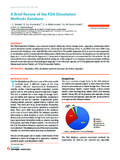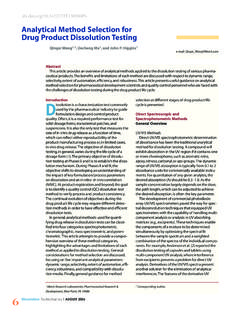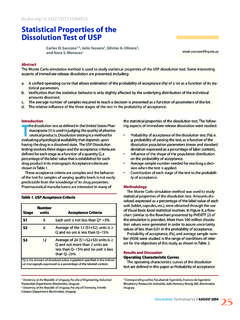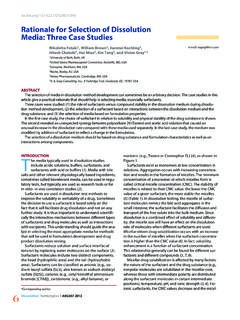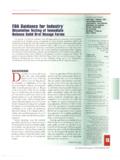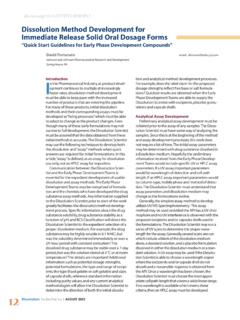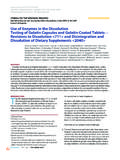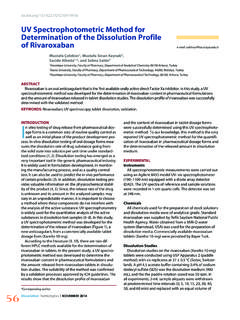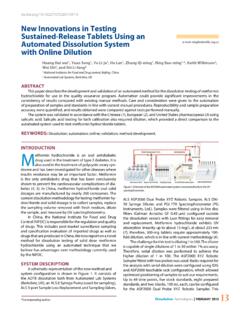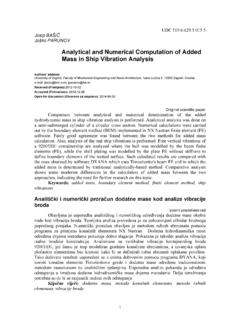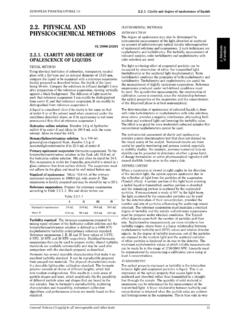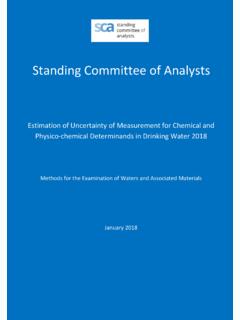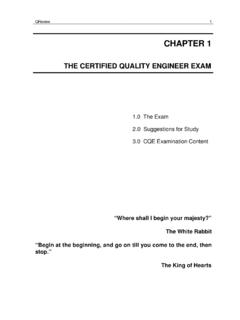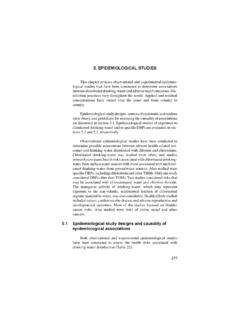Transcription of Comparison of US Pharmacopeia Simulated …
1 6 DissolutionTechnologies| MAY 2004 Comparison of US Pharmacopeia SimulatedIntestinal Fluid TS (without pancreatin) and Phosphate Standard Buffer pH ,TS of the International Pharmacopoeia with Respect to Their Use in In VitroDissolution TestingErika Stippler1,2, Sabine Kopp3,4, Jennifer B. solutions suitable for dissolution tests aredescribed as such only in The United StatesPharmacopeia (USP);The International Pharma-copoeia (IntPh), for example, broadly describes thecomposition of buffer solutions without specifyingtheir fields of applicability. In this study SimulatedIntestinal Fluid (SIFsp), which is described in The 26thUnited States Pharmacopeia (USP 26) as an Mbuffer solution containing potassium dihydrogenphosphate (the pancreatin is omitted from thecomposition for most dissolution testing applica-tions), and Phosphate Standard Buffer pH TS,which is described in Volume 1 of The InternationalPharmacopoeia,Third Edition, (IntPh 3)
2 As a mixtureof M potassium dihydrogen phosphate buffersolution and M di-sodium hydrogen phos-phate buffer solution, were investigated with respectto their interchangeability as dissolution test are pH phosphate buffers, and they havesimilar osmolalities (114 mOsmol/kg) and buffercapacities (18 mEq/L/pH/unit). However, in the USPmedium potassium (50mM) dominates over sodium(22mM) whereas in the IntPh buffer sodium( ) dominates over potassium (25mM). [Note:For the current investigations the IntPh phosphatebuffer media was used as monographed in the 3rdedition, Volume 1. With the publication of Volume 5the composition of the buffer pH medium hasbeen changed.]
3 Volume 5 describes a Mdisodium hydrogen phosphate buffer solution forBuffer pH ].The applicability and the interchangeability ofthese two compositionally similar but not identicalbuffers as dissolution media was investigated forproducts containing one of three drug substances:Metronidazole, a typical BCS Class 1 drug, andindometacin and ibuprofen, two drugs belonging toBCS Class 2. In each case several commercial prod-ucts currently available on the German market wereinvestigated. Products included uncoated, filmcoated, and sugar coated tablets as well as hardgelatin InvestigationsMaterialsChemical reference standard substances (CRS)Metronidazole CRS (lot 00616) was purchasedfrom Aldrich (Germany), indometacin CRS (lot0111A079) was purchased from Synopharm(Germany), and ibuprofen CRS (lot 10337012) waspurchased from Caelo (Germany).
4 ReagentsAll reagents used were of analytical grade andwere purchased from VWR (Germany).Dissolution mediaThe compositions of dissolution media used forin vitro dissolution testing are described in Table reagents were added to the deionized waterunder stirring to yield clear solutions. The pH valueof the dissolution media was checked and adjustedas necessary to pH with M sodiumhydroxide or M phosphoric acid preparationsThe pharmaceutical preparations (all conven-tional immediate release solid oral dosage forms)investigated are described in Table instrumentsDissolution tests were performed with the USP26 apparatus 2, using an Erweka model DT6R(Erweka, Germany) apparatus.
5 For manualsampling 5 mL syringes fitted with stainless tubingwere used. Samples were filtered immediately aftersampling through PTFE filter sticks with 45 m1J. W. Goethe University Frankfurt/Main, Department ofPharmaceutical Technology, Germany 2 PHAST GmbH, Homburg/Saar, Germany3 World Health Organization, Geneva, Switzerland4 The opinions expressed in this article are those of the author anddo not necessarily represent the decisions or stated policy of theWorld Health author, J. W. Goethe University Frankfurt/Main,Department of Pharmaceutical Technology, Biozentrum, Marie-Curie-Str. 9, 60439 Frankfurt, | MAY 2004pore size.
6 The dissolution system used was calibrated tomeet USP apparatus suitability test UV-Vis spectrophotometer model DU 640i (BeckmannCoulter, Germany) was used to analyze the samples fordissolved drug. The instrument was calibrated periodicallyaccording to the Pharmacopeial the pH measurements of dissolution media an MP230 pH meter (Mettler Toledo, Germany), calibrated daily,was measurements of osmotic pressure a semi-microosmometer (Knauer, Germany) was used. The semi-microosmometer was calibrated before use over the range from0 mOsmol/kg to 400 mOsmol/Kg with purified water andappropriate calibration Measurements of the osmotic pressure (osmolarity)The measurement of the osmotic pressure of both disso-lution media was performed according to the 4thEuropeanPharmacopoeia (Ph.)
7 Eur. 4) monograph, which specifiesthe freezing point method. The osmotic pressure of eachdissolution medium was determined in capacityThe buffer capacity was determinedaccording to the titration method andreported as the volume of strong acidadded to one liter buffer solution tolower its pH by one unit. This was deter-mined by adding 1 N hydrochloric acidsolution drop-wise from a 25 mL buretinto the 100 mL sample buffer solution,with constant stirring, until the pHdecreased by one pH unit. The investiga-tions were performed in triplicate foreach dissolution vitro dissolutionIn vitrodissolution tests wereperformed with the paddle apparatus in500 mL dissolution media at 75 rpm.
8 Thedissolutions were run in accordance withthe requirements of Ph. Eur. 4/ USP volumes of dissolutionmedia were degassed and then immedi-ately transferred into the vessels. Thetablets were placed in the vessels at thebeginning of each test and the stopwatchwas started simultaneously. Vessels werecovered during the run with plasticcovers in order to minimize temperature in the vessels was main-tained at 37+ C throughout each dissolution run. Therevolution rate was checked during all tests. Samples wereremoved manually using 5 mL syringes fitted with stainlesstubing to ensure reproducibility of the sampling were filtered immediately after sampling through45 m PTFE filter parameters used for the in vitrodissolution testingare described in Table substanceDrug product Technol.
9 DescriptionExpiry date IbuprofenIBU-Product A film coated Bsugar coated Auncoated Afilm coated Buncoated IntestinalFluid, pH (SIFsp);USP 26KH2PO4 NaOHdeionized water LPhosphate StandardBuffer pH 3KH2PO4Na2 HPO4deionized water L1 The composition of SIFsp is the same as in USP composition of the Phosphate Standard Buffer pH has beenchanged with the publication of Volume 5 of the of the methodMethod 1 Method 2 ApparatuspaddlepaddleDissolution mediumSimulated IntestinalFluid, pH (USP 26)Phosphate StandardBuffer pH (IntPh 3)DegassingyesyesVolume500 mL500 mLAgitation75 rpm75 rpmTemperature37 C37 CSampling time 10, 20, 30, 45, 60 min10, 20, 30, 45, 60 minTable 1: Composition of dissolution media for in vitrodissolution testing Table 2.
10 Pharmaceutical preparations under investigationTable 3: Description of the methods for dissolution testing8 DissolutionTechnologies| MAY 2004 AnalysisThe percent of drug dissolved at each sampling timepoint was determined for each drug product by UV UV measurements were performed in all cases at thewavelength of the relative maximum absorption of the drugsubstance, which was determined prior to each of % dissolved drugReference standard solutions were prepared by sepa-rately weighing portions of the chemical reference stan-dard substance. Reference standard solutions wereprepared and processed using the same method as for thepreparation of the sample solutions.
